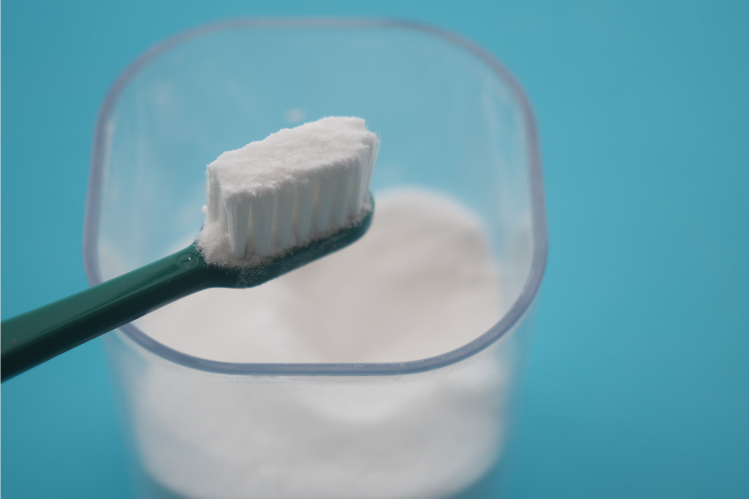
Tabla de contenido
- ¿Por qué la gente recurre al bicarbonato de sodio para los dientes?
- ¿El bicarbonato de sodio blanquea los dientes?
- La ciencia del bicarbonato de sodio para blanquear los dientes
- Cómo blanquear los dientes con bicarbonato de sodio (correctamente)
- Errores comunes al usar bicarbonato de sodio en los dientes
- ¿Es seguro el bicarbonato de sodio para los dientes?
- Bicarbonato de sodio vs. pasta de dientes: una comparación curiosa
- Los verdaderos pros y contras del bicarbonato de sodio para los dientes
- ¿Con qué frecuencia se debe utilizar bicarbonato de sodio en los dientes?
- Cuando el bicarbonato de sodio no es suficiente
- Lo que piensan los dentistas sobre el bicarbonato de sodio para blanquear los dientes
- ¿Puedes reemplazar la pasta de dientes con bicarbonato de sodio?
- Algunos consejos suaves antes de empezar
- Lo que el bicarbonato de sodio puede y no puede hacer
- Finalmente, ¿debería usted cepillarse los dientes con bicarbonato de sodio?
- Preguntas frecuentes
Hay algo extrañamente reconfortante en los remedios caseros. Quizás sea su simplicidad. Esa tranquila confianza en las cosas. que no provienen de un laboratorio, sino de lo más profundo de tu despensa. Y cuando se trata de remedios para blanquear los dientes, hornear... El bicarbonato cobra protagonismo. Ese delicado polvo blanco, escondido cerca de la harina. La gente lo espolvorea en las masas. frigoríficos, y ahora… cepillos de dientes.
Algunos lo llaman el arma secreta para una sonrisa más blanca. Otros lo consideran demasiado agresivo y arriesgado. ¿La verdad? Es complicado. Pero también fascinante. Hablemos con sinceridad sobre el bicarbonato de sodio para los dientes.
¿Por qué la gente recurre al bicarbonato de sodio para los dientes?

Retrocedamos unas décadas en el calendario. A la época en que la gente se limpiaba los dientes con polvos sencillos. Polvos como Carbón triturado, sal, conchas molidas y, sí, bicarbonato de sodio. Este último era el más común.
Pero ¿por qué la gente recurrió a él? Hay una lógica ancestral. El bicarbonato de sodio es ligeramente abrasivo. Puede pulir La superficie del esmalte. Además, también es alcalina, lo que ayuda a neutralizar el ácido, el culpable invisible de la caries.
Y como cuesta casi nada, el bicarbonato de sodio se siente popular. Cualquiera puede usarlo.
En cuanto a los resultados, el bicarbonato de sodio ha demostrado tener cierto poder blanqueador. Funciona lo suficiente como para marcar una diferencia visible. Café Las manchas se aclaran un poco. Ese tono amarillo apagado se suaviza. La boca se siente más fresca, quizás un poco más limpia de lo habitual. No es dramático, pero sí satisfactorio. Como ordenar un escritorio desordenado.
Aquí encontrará más información sobre los métodos naturales de blanqueamiento dental que realmente funcionan si desea explorarlos.
¿El bicarbonato de sodio blanquea los dientes?
Esa es la pregunta que ronda la mente de todos los que buscan opciones para blanquear sus dientes. La respuesta, como la mayoría de las cosas... Vale la pena entenderlo y está en algún punto intermedio.
El bicarbonato de sodio no blanquea. No contiene peróxido de hidrógeno ni peróxido de carbamida. Los ingredientes que químicamente... Disuelve las manchas profundas. Lo que hace es eliminar suavemente la decoloración superficial. La película exterior que opaca el brillo de su ¿Esmalte? Ahí es donde funciona.
Así que, técnicamente, sí. El bicarbonato de sodio blanquea los dientes, pero solo de la misma manera que pulir la plata restaura su brillo. No estás... Al cambiar el metal, se revela lo que ya está ahí. Y quizá eso sea suficiente para la mayoría. No es perfecto. blancura, pero limpieza honesta.
En general, se considera un buen remedio para blanquear los dientes en casa.
La ciencia del bicarbonato de sodio para blanquear los dientes
Seamos un poco científicos por un segundo.
El bicarbonato de sodio tiene una propiedad abrasiva suave. Al cepillarlo, sus finos gránulos ayudan a restregar. Elimina la placa y las moléculas de tinción adheridas al esmalte. También altera el equilibrio del pH en la boca, lo que dificulta Para que las bacterias prosperen.
Los estudios han demostrado que las pastas dentales que contienen bicarbonato de sodio eliminan las manchas con mayor eficacia que las que no lo contienen. Suave pero eficaz. Como una exfoliación para tu sonrisa.
Pero aquí está la cuestión: la moderación importa.
Con un uso excesivo, esa misma abrasión puede desgastar el esmalte. Lentamente, de forma invisible. El esmalte no se regenera. Una vez... Se acabó, se acabó. Así que, aunque el bicarbonato de sodio puede ayudar a blanquear, también puede ser perjudicial si te excedes.
Cómo blanquear los dientes con bicarbonato de sodio (correctamente)

No necesitas convertir tu baño en un laboratorio de ciencias para esto. Basta con una cuchara, un cepillo y un poco de atención. Aquí te explicamos cómo hacerlo correctamente:
-
Mezclar una pasta.
Una cucharadita de bicarbonato de sodio y unas gotas de agua. Mezclar hasta obtener una mezcla espesa y suave. Puedes añadir un chorrito. de tu pasta de dientes habitual si te gusta el sabor o quieres el refuerzo de flúor.
-
Cepille suavemente.
Sumerge tu cepillo de cerdas suaves en la pasta. Haz pequeños movimientos circulares, sin frotar. Piensa en "pulir", no... "raspado." Dos minutos máximo.
-
Enjuague bien.
El bicarbonato de sodio deja un residuo granulado si no se limpia con cuidado. Escupe, enjuaga y repite.
-
Limitarlo.
Una o dos veces por semana es lo ideal. Con más frecuencia, corre el riesgo de debilitar el esmalte.
Sentirás la diferencia. Dientes más lisos, quizás un poco más brillantes. Es sutil, pero real.
Errores comunes al usar bicarbonato de sodio en los dientes
Esta parte importa casi tanto como el “cómo”.
A la gente le encanta mejorar los remedios caseros, y ahí es donde suelen empezar los problemas. Mezclar bicarbonato de sodio con jugo de limón, ¿Vinagre o vinagre de sidra de manzana? Mala idea. El ácido de esos ingredientes ablanda el esmalte, y el bicarbonato de sodio... termina el trabajo raspándolo.
Otros lo combinan con peróxido de hidrógeno en proporciones aleatorias. Puede funcionar en formulaciones controladas, pero las versiones caseras... Son impredecibles y duras.
Luego está el estilo de cepillado. Si se cepilla demasiado fuerte o durante demasiado tiempo, se pierde esmalte. Las encías sufren primero, luego... Esmalte. Si vas a usar bicarbonato de sodio, trátalo con respeto. Es una herramienta, no un truco.
¿Es seguro el bicarbonato de sodio para los dientes?
Úselo con moderación, sí. Es completamente seguro para la mayoría de las personas.
Tiene un índice de abrasividad relativamente bajo en comparación con muchas pastas blanqueadoras. No contiene químicos agresivos y Incluso puede refrescar el aliento neutralizando los ácidos que causan el mal olor.
Pero si sus dientes ya son sensibles o tiene carillas, aparatos ortopédicos o coronas, consulte primero con su dentista. El bicarbonato de sodio puede opacar la superficie de ciertos materiales. Piénselo así: es seguro en pequeñas dosis, pero arriesgado en... hábitos.
Bicarbonato de sodio vs. pasta de dientes: una comparación curiosa
Ambos limpian. Ambos blanquean. Pero viven en mundos diferentes.
- La pasta de dientes es multiusos. Limpia, fortalece, protege y refresca. Contiene flúor, que protege contra las caries.
- El bicarbonato de sodio, por su parte, es minimalista. Limpia y equilibra, pero nada más.
Sin embargo, no tienen por qué competir. De hecho, algunas de las mejores pastas dentales blanqueadoras con bicarbonato de sodio combinan ambos. Ofreciendo poder de pulido sin el riesgo de frotar demasiado.
No se trata de “ o esto o aquello ”. Se trata de “ ambos, sabiamente ”.
Los verdaderos pros y contras del bicarbonato de sodio para los dientes

Seamos honestos al respecto.
Ventajas del bicarbonato de sodio para los dientes
Estas son las ventajas:
- Barato y fácil de encontrar.
- Elimina las manchas superficiales de forma natural.
- Neutraliza la acidez de la boca.
- Ayuda a refrescar el aliento.
- Libre de colorantes o químicos agresivos.
Desventajas del bicarbonato de sodio para los dientes
Estas son las desventajas:
- Sin flúor (sin protección contra las caries)
- Puede desgastar el esmalte si se usa en exceso.
- Sabor y textura arenosos
- No elimina las manchas profundas
- Puede secar ligeramente la boca.
Es un método antiguo que todavía se mantiene vigente, con salvedades.
¿Con qué frecuencia se debe utilizar bicarbonato de sodio en los dientes?
Esto depende de tus dientes, el grosor del esmalte y tus hábitos. Pero, por lo general, una o dos veces por semana es suficiente. Si Lo combinas con pasta dental blanqueadora, o incluso menos. El objetivo es pulir, no castigar.
Prueba este ritmo: bicarbonato los fines de semana, pasta de dientes entre semana. Eso le da espacio a tu esmalte. Aun así, es... Se recomienda evitar por completo el bicarbonato de sodio si estás usando algún tratamiento blanqueador.
Cuando el bicarbonato de sodio no es suficiente
Aquí es donde entra en juego la realidad.
Para manchas leves, el bicarbonato de sodio puede hacer maravillas. Pero si buscas un blanqueamiento notable, necesitarás algo... Más fuerte. Ahí es donde entran en juego los kits blanqueadores profesionales o caseros . Utilizan geles a base de peróxido que descomponen las manchas más difíciles.
Entre las mejores opciones disponibles, el kit de blanqueamiento dental de ALIGNERCO ofrece un equilibrio. Está formulado con peróxido, pero... Suave, combinado con un acelerador LED que amplifica el efecto sin ser agresivo. Fácil de usar, puedes... Mientras disfrutas de tu programa favorito.
Lo que piensan los dentistas sobre el bicarbonato de sodio para los dientes Blanqueo
La mayoría de los dentistas se muestran sorprendentemente tranquilos al respecto.
Te dirán que el bicarbonato de sodio es bueno para controlar las manchas, pero no como tu principal método de cuidado bucal. No combate Caries o fortalecer el esmalte. Además, el uso excesivo puede aumentar la sensibilidad dental. ¿Pero como complemento? Es perfectamente razonable. Muchos incluso recomiendan cambiar la pasta dental con bicarbonato de sodio por una pasta dental con flúor normal para lograr una rutina equilibrada.
Así es. Los dentistas no están en contra del bicarbonato de sodio. Están en contra de excederse.
¿Puedes reemplazar la pasta de dientes con bicarbonato de sodio?
No. O al menos no deberías.
La pasta dental común es más que un limpiador. Es un cuidado preventivo. Aporta flúor, sella los microporos y mantiene... Salud bucal a largo plazo. Si solo usa bicarbonato de sodio, sus dientes pueden verse limpios, pero no están tan protegidos. Con el tiempo, notarás más sensibilidad y quizá incluso se formen pequeñas caries silenciosamente.
Así que úselo junto con el otro, no en lugar de él.
Algunos consejos suaves antes de empezar
Algunos pequeños recordatorios basados en la experiencia:
- No se cepille los dientes inmediatamente después de comer cítricos o beber refresco: el esmalte se ablanda temporalmente.
- Enjuague siempre bien después de usar bicarbonato de sodio.
- Las pastas dentales con bicarbonato de sodio compradas en tiendas son más seguras para el uso frecuente.
- Continúe con un enjuague bucal con flúor para mantener el esmalte fuerte.
Y si empiezas a sentir los dientes ásperos o sensibles, tómate un descanso. Equilibrio, siempre equilibrio.
Lo que el bicarbonato de sodio puede y no puede hacer
Retrocedamos un momento. ¿Qué ofrece realmente este humilde polvo?
| Lata de bicarbonato de sodio | El bicarbonato de sodio no puede |
|---|---|
| Limpia la superficie de tus dientes | Esmalte blanqueador |
| Levanta las manchas suavemente | Eliminar manchas intrínsecas profundas |
| Refresca tu aliento | Reemplazar la atención profesional |
| Equilibrar el pH oral | Reparar daños en el esmalte |
En resumen, es mantenimiento. No magia.
Finalmente, ¿debería usted cepillarse los dientes con bicarbonato de sodio?
Sí.
El bicarbonato de sodio para blanquear los dientes no es nuevo. Se ha utilizado durante generaciones, ayudando a las personas a mantener su sonrisa. brillante con nada más que una cuchara y un cepillo. Es suave, si se usa con cuidado. Es barato, accesible y algo así. Poético. La idea de que algo tan simple aún pueda tener valor en un mundo obsesionado con la alta tecnología.
Pero conoce sus límites. Pule, mantiene y refresca. No transforma. Para un blanqueamiento más profundo, hay... área Hay muchísimas opciones para elegir. Al final, quizás el mejor enfoque sea una mezcla de ambos mundos. Un poco antiguo sabiduría, Un poco de ciencia nueva.
Preguntas frecuentes
1. ¿Cómo utilizar correctamente el bicarbonato de sodio en los dientes?
Humedezca su cepillo de dientes, sumérjalo ligeramente en bicarbonato de sodio y cepíllelo suavemente con movimientos circulares. mociones durante unos dos minutos antes de enjuagar bien.
2. ¿Cuánto tiempo debo dejar actuar el bicarbonato de sodio en mis dientes?
No más de dos minutos: dejarlo más tiempo no mejora los resultados y podría desgastarlo. esmalte con el tiempo.
3. ¿Con qué frecuencia debes cepillarte los dientes con bicarbonato de sodio?
Una o dos veces por semana suele ser suficiente. El uso diario puede ser demasiado abrasivo para la mayoría de las personas. esmalte.
4. ¿Debes enjuagarte la boca después de usar bicarbonato de sodio?
Por supuesto. Enjuágate bien con agua para eliminar los residuos y restaurar la salud bucal. equilibrio natural.
5. ¿Puede el bicarbonato de sodio arreglar los dientes amarillos?
Puede ayudar a aclarar las manchas superficiales, pero no cambiará drásticamente el color de sus dientes. Para un blanqueamiento más profundo, funcionan mejor los kits de blanqueamiento profesionales o de uso casero.
6. ¿Puedo mezclar bicarbonato de sodio con mi pasta de dientes?
Sí, puedes. Mezclar una pizca de bicarbonato de sodio con tu pasta de dientes habitual te proporciona un alivio suave. Poder blanqueador sin saltarse la protección con flúor.
Citas:
Healthline. Lo que debes saber sobre el cepillado de dientes con bicarbonato de sodio.
https://www.healthline.com/health/baking-soda-toothpaste
Colgate. ¿El bicarbonato de sodio blanquea los dientes?
https://www.colgate.com/es-us/salud-bucal/blanqueamiento-dental/¿el-bicarbonato-de-sodio-blanquea-los-dientes?
Li Y. Eliminación de manchas y blanqueamiento con dentífrico con bicarbonato de sodio: Una revisión de la literatura. J Am Dent Assoc. 2017 Noviembre;148(11S):S20-S26. doi: 10.1016/j.adaj.2017.09.006.
https://pubmed.ncbi.nlm.nih.gov/29056186/







